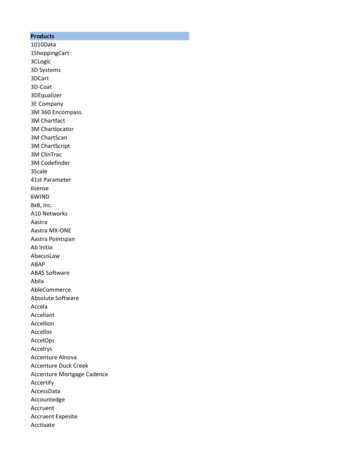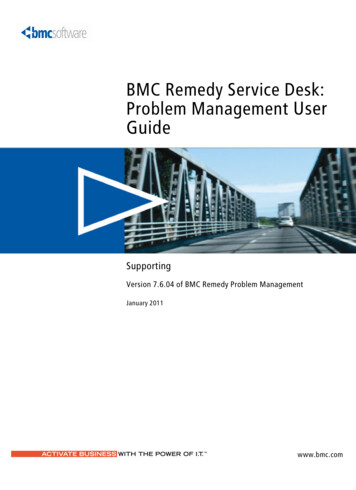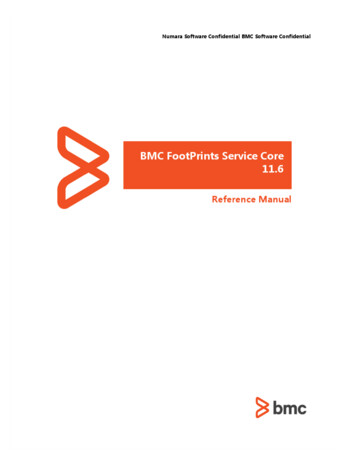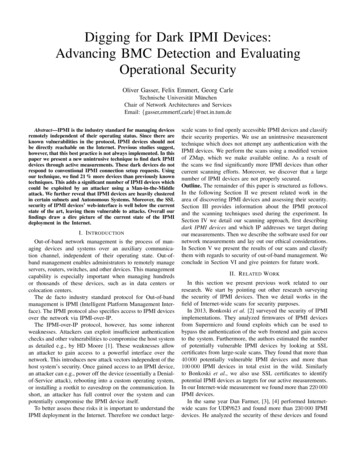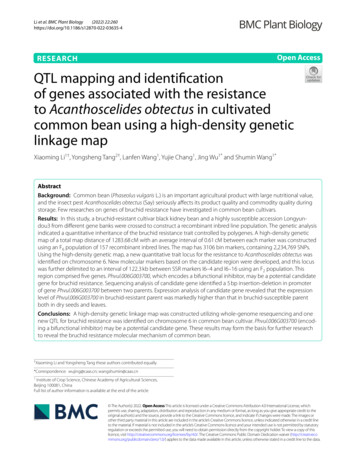
Transcription
(2022) 22:260Li et al. BMC Plant pen AccessRESEARCHQTL mapping and identificationof genes associated with the resistanceto Acanthoscelides obtectus in cultivatedcommon bean using a high‑density geneticlinkage mapXiaoming Li1†, Yongsheng Tang2†, Lanfen Wang1, Yujie Chang1, Jing Wu1* and Shumin Wang1*AbstractBackground: Common bean (Phaseolus vulgaris L.) is an important agricultural product with large nutritional value,and the insect pest Acanthoscelides obtectus (Say) seriously affects its product quality and commodity quality duringstorage. Few researches on genes of bruchid resistance have investigated in common bean cultivars.Results: In this study, a bruchid-resistant cultivar black kidney bean and a highly susceptible accession Longyundou3 from different gene banks were crossed to construct a recombinant inbred line population. The genetic analysisindicated a quantitative inheritance of the bruchid resistance trait controlled by polygenes. A high-density geneticmap of a total map distance of 1283.68 cM with an average interval of 0.61 cM between each marker was constructedusing an F6 population of 157 recombinant inbred lines. The map has 3106 bin markers, containing 2,234,769 SNPs.Using the high-density genetic map, a new quantitative trait locus for the resistance to Acanthoscelides obtectus wasidentified on chromosome 6. New molecular markers based on the candidate region were developed, and this locuswas further delimited to an interval of 122.3 kb between SSR markers I6–4 and I6–16 using an F2 population. Thisregion comprised five genes. Phvul.006G003700, which encodes a bifunctional inhibitor, may be a potential candidategene for bruchid resistance. Sequencing analysis of candidate gene identified a 5 bp insertion-deletion in promoterof gene Phvul.006G003700 between two parents. Expression analysis of candidate gene revealed that the expressionlevel of Phvul.006G003700 in bruchid-resistant parent was markedly higher than that in bruchid-susceptible parentboth in dry seeds and leaves.Conclusions: A high-density genetic linkage map was constructed utilizing whole-genome resequencing and onenew QTL for bruchid resistance was identified on chromosome 6 in common bean cultivar. Phvul.006G003700 (encoding a bifunctional inhibitor) may be a potential candidate gene. These results may form the basis for further researchto reveal the bruchid resistance molecular mechanism of common bean.†Xiaoming Li and Yongsheng Tang these authors contributed equally.*Correspondence: wujing@caas.cn; wangshumin@caas.cn1Institute of Crop Science, Chinese Academy of Agricultural Sciences,Beijing 100081, ChinaFull list of author information is available at the end of the article The Author(s) 2022. Open Access This article is licensed under a Creative Commons Attribution 4.0 International License, whichpermits use, sharing, adaptation, distribution and reproduction in any medium or format, as long as you give appropriate credit to theoriginal author(s) and the source, provide a link to the Creative Commons licence, and indicate if changes were made. The images orother third party material in this article are included in the article’s Creative Commons licence, unless indicated otherwise in a credit lineto the material. If material is not included in the article’s Creative Commons licence and your intended use is not permitted by statutoryregulation or exceeds the permitted use, you will need to obtain permission directly from the copyright holder. To view a copy of thislicence, visit http:// creat iveco mmons. org/ licen ses/ by/4. 0/. The Creative Commons Public Domain Dedication waiver (http:// creat iveco mmons. org/ publi cdoma in/ zero/1. 0/) applies to the data made available in this article, unless otherwise stated in a credit line to the data.
Li et al. BMC Plant Biology(2022) 22:260Page 2 of 15Keywords: Common bean, Acanthoscelides obtectus , Bruchid resistance, High-density genetic linkage map, QTLBackgroundCommon bean (Phaseolus vulgaris L.) is one of the mostwidely adapted legumes in the developing world and themost important food legume for direct human consumption in the world [1, 2]. This autodiploid (2n 2x 22)species has 11 chromosomes and a genome size of about537 Mb (Phaseolus vulgaris v2.1, DOE-JGI and USDANIFA, http:// phyto zome. jgi. doe. gov/). Common beanis an annual and self-pollinating plant, and its seeds arerich in protein, amino acids, flavonoids, alkaloids andterpenoids, which are necessary for human life [3–6].Common bean originated from Mesoamerica, and Chinais considered as a secondary centre of common beandiversity and has a long history of cultivation [7, 8]. Common bean is an important source of plant protein in thehuman dietary structure and is one of the main exportproducts of China [9].During their storage, legume seeds are often damagedby legume weevils, which lead to a serious decrease inyield. Bean weevils [Acanthoscelides obtectus (Say)] andMexican bean weevils [Zabrotes subfasciatus (Boheman)]are the main insect pests of common bean during storage [10, 11]. Acanthoscelides obtectus (Say) originatedfrom South America and Central America and has beenintroduced into dozens of countries and regions, such asAfghanistan, Japan, Myanmar and China, through international trade and introduction channels [12]. The larvae of A. obtectus can enter the bean seeds for feeding.The adults fly to the fields or warehouses and continueto damage common bean, causing great losses [13, 14].The damage and weight loss rates of common bean in thefield are 30% 38% and 6% 8%, respectively, and storage increases these values to 74% and 64%, respectively,which indicates that the damage created by bruchidsis more serious during the storage period [15–17]. Atpresent, the commonly used physical methods, including freezing [18–20], boiling and seed dressing treatment [21] as well as chemical methods of fumigationwith chemical agents such as phosphine [22] and ethylformate [23], and biological control [24, 25] are appliedto control seeds damage by bruchids, but the negativeimpacts on the seeds themselves and the environmentare substantial.Because the growth and development of insects areaffected by the chemical components in plants [26],which can kill, resist, avoid insects or inhibit theirgrowth, the direct utilization of plants themselves to prevent and control pests has become a research hotspot.Many common bean varieties are resistant to azuki beanweevils (Callosobruchus chinensis) and cowpea weevils(Callosobruchus maculatus) because they contain special seed proteins [27]. Theses proteins are componentsof a polygene family encoded by APA locus [arcelin (Arc),phytohemagglutinin (PHA), and α-amylase inhibitor(αAI)] and are most abundant in PHA and αAI [28–33].PHA and αAI are the most representative members ofthe lectin family and normally occur in wild and cultivated accessions of common bean. Arcelin is found onlyin some wild Mexican bean varieties but not in cultivatedbean varieties [34–36]. The wild common bean germplasms G02771 (containing ARC-5 protein) [37], G12882(including ARC-1) [33], RAZ106 (containing ARC-1),G12866 (including ARC-2) [38], G24582 (including ARC7), G24582A (including ARC-7) and G24584 (including ARC-7) [39] are effective against the Mexican beanweevils. The wild bean germplasms G12952 (ARC-4),G12949 (ARC-4) [32] and QUES (ARC-8) [40] are resistant to both A. obtectus and Z. subfasciatus. Baldin et al.[41] screened 18 common bean genotypes of AndeanAmerican and Mesoamerican origin, and the commonbean genotypes Arc.1, Arc.2, Arc.1S, Arc.3S, and Arc.5Swere identified as resistant to A. obtectus. Some Bulgarian common bean genotypes and commonly grown Turkish bean genotypes were resistant against A. obtectus [42,43]. Although an increasing number of common beangermplasms resistant to weevils have been discovered,most of these are concentrated in wild beans, and few areconcentrated in cultivated beans.At present, researches on bruchid resistance genescloning are lagging behind both at home and abroad,and in particular, few studies have investigated on resistance genes in common bean cultivars using molecularmarkers. Blair et al. [44] used SSR molecular markers toidentify a locus linked to arcelin 1 allele from the wildcommon bean accession RAZ106 and found that thislocus was located at the APA locus on Pv04. Kamfwaet al. [45] mapped two QTLs on chromosome 4 (oneassociated with the APA locus) and one QTL on chromosome 6 using an A. obtectus resistant breeding lineintrogressed from the wild tepary bean (contained Arcelin gene). Lectin can be encoded by a single locus or byseveral loci, for example, APA locus located on Pv04, Lec2 and Lec-3, and the lec genes mapping on Pv07 [46, 47].In this study, we found that the black kidney bean, acultivar of common bean, has high resistance to Acanthoscelides obtectus (Say). We then constructed a highdensity genetic linkage map using a recombinant inbredline population obtained from a cross between the
Li et al. BMC Plant Biology(2022) 22:260bruchid-susceptible cultivar Longyundou3 and black kidney bean and performed gene mapping of bruchid resistance. This study mapped and analyzed the resistancegenes for bean weevils in cultivated common bean, whichmay lay a foundation for further study on the mechanismof bruchid resistance in common bean and provide a possibility for improved seed preservation.ResultsBruchid resistance segregation and genetic analysisThe black kidney bean (BKB) exhibited resistance toAcanthoscelides obtectus (Say), with a mean percentageof damaged seeds of 28.3%. In contrast, Longyundou3(LYD3) showed high susceptibility, and all the seeds weredamaged by bruchids (percentage of damaged seedsequal to 100%) (Fig. 1a, b).The resistance of F2:3 population and RILs was identified. Two traits, namely, the percentage of damaged seeds(PDS) and the number of perforations (NP), were investigated. The PDS among the F2:3 families ranged from 0 to100%, and the NP ranged from 0 to 220, showing significant resistance segregation (Fig. 1c). The PDS in the RILsPage 3 of 15ranged from 0 to 100%, and the NP ranged from 0 to 280.However, the minimum damage rate of seeds was lowerthan that of resistant parent, which indicated that resistant trait had a positive superparent advantage. The distribution of bruchid resistance was continuous in the F2:3population, and the ratio of susceptibility to resistancewas not consistent with Mendelian inheritance. The kurtosis and skewness values were 0.84 and 0.11, respectively, with the absolute values lower than one, which wasapproximately normal, and these results indicated thequantitative inheritance of the resistance trait controlledby polygenes.High‑density genetic linkage map constructionBased on the technical characteristics of whole genomeresequencing, the 157 RILs and two parents of commonbean were resequenced. Raw reads were obtained byCASAVA base calling and conversion from the raw imagedata acquired by high-throughput sequencing. After filtering, 80,029,096 (17.12 coverage) and 71,913,622(16.95 coverage) clean reads were generated fromBKB (resistant parent) and LYD3 (susceptible parent),Fig. 1 Phenotypic characteristics and frequency distribution of PDS and NP in the F 2:3 families. The F2:3 families were derived from a cross betweenLYD3 (bruchid-susceptible parent) and BKB (bruchid-resistant parent). a Phenotypic characteristics of the two parents before infestation with beanweevils. b Phenotypic characteristics of the two parents after infestation with bean weevils. The large-yellow seeds on the left are the susceptibleparent LYD3, and the small-black seeds on the right are from the resistant parent BKB. c Frequency distribution of the PDS and NP in the F 2:3 familiesfrom a cross of LYD3 and BKB
Li et al. BMC Plant Biology(2022) 22:260Page 4 of 15Table 1 Description of the basic characteristics of the genetic linkage mapLG IDaBin numberbEffective Bin NumbercSNP NumberMap lengthd (cM)Average distancee (cM)Max Gapf 431062,234,7691283.680.6113.392.26The high-density genetic linkage map in this study contained 11 linkage groupsaLG ID represents the number of linkage groupsbBin number represents the total number of bin markers in each groupcEffective bin number represents the total number of bin markers after filtering out biased separation markersdMap length represents genetic distance of a linkage groupeAverage distance (cM) represents the average genetic distance of bin markers on each linkage groupfMax gap (cM) represents the biggest gap in each linkage groupgcM/Mb represents the conversion ratio between genetic distance and physical distancerespectively. The clean reads from 157 RILs ranged from39,686,552 to 105,924,272, with an average sequencingdepth of 14.38 coverage. By comparing the sequencing data of BKB, LYD3 and 157 RILs with the referencegenome, a total of 300,003 SNPs among the parents werescreened out using GATK 3.8 software [48].The sliding window approach, with 15 SNPs in eachsliding window, was used in this study. According to theproportion of SNP markers in the sliding window fromthe male or female parents, the genotype of the segmentin where the sliding window located was determined,and the location of the recombination breakpoint of thechromosome segment was determined. When the sliding window hit a homozygous/homozygous breakpoint,the genotype transiently changed from homozygous toheterozygous and then changed to the other homozygous genotype. A genotype remained unchanged until ithit a recombination breakpoint [49]. After all genotypeswere called and the recombination breakpoints weredetermined, we identified a total of 48,689 recombinantbreakpoints, with an average of 310 breakpoints per RIL(Fig. S1a).By consolidating continuous non-recombinationmarkers on the genome into a bin, a total of 4214recombination bins were obtained for the 157 RILs.The average physical length of the recombination binswas 135.2 kb, including 712 SNPs. Each bin was usedas a marker for genetic marker screening and geneticlinkage map construction. Because segregation distortion could affect the results of map construction andQTL mapping, a ratio of 1:1 was used to perform segregation filtration with 4214 candidate markers, and 1108biased markers were filtered out to yield 3106 effectivemarkers. According to the genome information [50],the linkage groups were constructed using JoinMap 4.0software [51] by controlling the LOD value between 2.0and 10.0. A total of 11 linkage groups were generatedwith 3106 bin markers, containing 2,234,769 SNPs. Taking the linkage group as the unit, the genetic distancebetween the markers was calculated using the Kosambi algorithm. A high-density genetic map of a totalmap distance of 1283.68 cM, with an average intervalof 0.61 cM between the bin markers, was constructed(Table 1, Fig. 2). The number of effective bin markers in each chromosome ranged from 134 to 417. Thelength of each chromosome ranged from 79.23 cM to166.73 cM, and the average distance between bin markers ranged from 0.43 cM to 0.80 cM. With the exceptionof biggest gap 10-cM on LG05 and LG08, all other biggest gaps were 8-cM. The conversion ratio betweengenetic distance and physical distance ranged from1.67 to 2.79. LG08 was the longest with a map lengthof 166.73 cM, containing 417 bin markers with 297,249SNPs, and had an average genetic distance of 0.71 cM.LG03 was the second longest with a map length of159.84 cM containing 289,659 SNPs. LG09 and LG01
Li et al. BMC Plant Biology(2022) 22:260Page 5 of 15Fig. 2 Genetic map of RILs from a cross between LYD3 and BKB. A high-density genetic map containing 11 chromosomes was constructed using157 RILs derived from a cross between LYD3 (bruchid-susceptible parent) and BKB (bruchid-resistant parent). The bar on the left represents thegenetic distance. The total genetic distance of the high-density map was 1283.68 cM, with an average interval of 0.61 cM between the bin markers.Chromosome 8 was the longest with a map length of 166.73 cM, contained 417 bin markers with 297,249 SNPs and had an average geneticdistance of 0.71 cM. Chromosome 9 was the shortest, with a map length of 79.23 cM, which included 134 bin markers with an average geneticdistance of 0.43 cM. The black lines represent the relative position of the bin markers on the genetic linkage group. More of the black lines indicatedenser markerswere the two shortest with map lengths of 79.23 cM and95.36 cM, including 134 bin markers with 110,344 SNPsand 364 bin markers with 246,412 SNPs, respectively,and the average genetic distances of LG09 and LG01were 0.43 cM and 0.63 cM.Collinearity analysis was performed based on thepositions of markers on the genome and the geneticmap, and the results showed that the order of mostmarker positions on each linkage group was consistent with the chromosome (Fig. S1b), indicating good
Li et al. BMC Plant Biology(2022) 22:260Page 6 of 15collinearity, high accuracy of the genetic recombinationrate and high accuracy of the map construction.QTL analysis and mapping for bruchid resistanceThe genetic map was used to identify QTLs controllingbruchid resistance in common bean. After the identification of bruchid resistance, the PDS of the RILsranged from 0 to 100%, and the NP ranged from 0 to280. There was a significant positive correlation betweenthe two phenotypes, with a correlation coefficient of0.88 (Fig. S2). The ICIM-ADD method in QTL IciMapping 4.2 software was used to analyse PDS and NP. Theanalysis of the 157 RILs detected one QTL associatedwith PDS located on chromosome 6 between markersBin1565 and Bin1566. The LOD value was 5.49, explaining 16.10% of the phenotypic variation, and the additiveeffect was 0.11. One QTL related to NP, which wasalso located on chromosome 6 between markers Bin1565and Bin1566, had the LOD value of 4.31 and additiveeffect of 27.48, and explained 16.37% of the phenotypic variation (Table 2; Fig. 3a; Fig. S3). This QTL forboth PDS and NP between markers Bin1565 and Bin1566was 0.23 cM, and located at the physical position between1,250,000 and 1,500,000 bp on chromosome 6 (Fig. 3b).Table 2 Location and effects of QTLs controlling resistance to Acanthoscelides obtectus detected in RILstraitQTL namePDSqAO6.1NPaChromosomeMarker intervalaInterval in1565-Bin15660.234.3116.37The QTL was located between left and right markersbThe LOD threshold was determined using 1000 permutationscPVE was the phenotypic variation explained by the QTLdAdd represents the additive effectAddd 0.11 27.48Fig. 3 Genetic and physical maps of QTL loci for resistance to Acanthoscelides obtectus and candidate genes analysis. a Genetic map of the QTLfor both PDS and NP in linkage group 6 using 157 RILs derived from LYD3 BKB. The markers list at the right and left are the genetic positions(cM). b Physical map of the bin markers on chromosome 6. The markers list on the left and right are the physical positions in base pairs (bp).c Delimitation of the qAO6.1 locus to a 122.3 kb region of chromosome 6. d Predicted candidate genes between markers I6–4 and I6–16 accordingto the physical position on the reference genome common bean accession G19833v1.0
Li et al. BMC Plant Biology(2022) 22:260Page 7 of 15We named the QTL qAO6.1, and the beneficial allelesat this locus came from BKB, the resistant parent. TheqAO6.1 might be a major locus for resistance to Acanthoscelides obtectus.For narrowing down the region identified by QTL-seq,we developed 44 SSR markers and 5 InDel markers (TableS1) on chromosome 6 in candidate region to detect polymorphisms between BKB and LYD3. A total 11 SSRmarkers and 3 InDel markers on chromosome 6 werepolymorphic between the two parents. The regionallinkage map for chromosome 6 were constructed withpolymorphic DNA markers using F2 mapping population consisted of 188 individual plants. We identified tenrecombinants from the fine-mapping population usingseven molecular markers. The qAO6.1 locus was delimited to an interval of approximately 122.3 kb between SSRmarkers I6–4 and I6–16 (Fig. 3c).To further verify the correlation between this locusand bruchid resistance, an association study in candidate region was conducted using SNP markers and thephenotypic data of two traits, PDS and NP, of one natural population (contained 628 common bean accessions) (Table S2). A total 437 SNPs were generated fromthe whole genome resequencing project between I6–4(Pv06, 1,367,622 bp) and I6–16 (Pv06, 1,489,891 bp)on chromosome 6. The results showed that 70 SNPs(P-value 1 10 6) associated with PDS and 7 SNPs(P-value 1 10 6) associated with NP were detected(Table S3). Seven SNPs (Pv06 1413364, Pv06 1429130,Pv06 1429225,Pv06 1429229,Pv06 1429376,Pv06 1432127, Pv06 1,432,316) were associated withboth two traits. The peak SNP (SNP with the lowestP-value) was located in 1,432,316 bp on chromosome6 (PDS-associated Pv06 1,432,316, P 8.38 10 28;NP-associated Pv06 1,432,316, P 3.44 10 12) (Fig.S3). Four SNPs associated with PDS (Pv06 1376148,Pv06 1376347, Pv06 1376967 and Pv06 1407036) werelocated within genes, others located between genes.These results suggested that this locus might be stronglyassociated with bruchid resistance.Annotation and candidate gene prediction for candidateregionAccording to the common bean reference genomesequence of G19833v1.0, the region between markersI6–4 and I6–16 contained five genes, Phvul.006G003700(Pv06,1,376,123–1,378,343 bp),Phvul.006G003800(Pv06,1,406,616–1,408,098 bp),Phvul.006G003900(Pv06,1,417,873–1,419,245 bp),Phvul.006G004000(Pv06, 1,454,577–1,457,697 bp) and Phvul.006G004100(Pv06, 1,486,729–1,491,368 bp) (Fig. 3d; Table 3).Phvul.006G003700 was found to be a homologousgene in A. thaliana according to the NCBI databaseand encoded a bifunctional inhibitor/seed storage/LTP family protein, belonging to the AAI-LTSS [alphaamylase inhibitor (AAI), lipid transfer (LT) and seedstorage (SS)] protein superfamily. The AAI-LTSS family is known to play important roles in defending plantsfrom insects and pathogens, in lipid transport betweenintracellular membranes, and in nutrient storage. TheBLAST searches against the NCBI and UniProt databasesrevealed that Phvul.006G003700 showed the strongestsimilarity to an AAI domain-containing protein in Phaseolus vulgaris (kidney bean) (identity 91.29%) and anAAI domain-containing protein in Glycine max (soybean) (E-value 0.0, score 1614, identity 77.9%),and it is speculated that the protein encoded byPhvul.006G003700 might have a similar function ofinhibiting α-amylase activity. Phvul.006G003800 encodesa carbohydrate-binding X8 domain superfamily protein. Phvul.006G004000 and Phvul.006G004100 encodehomologues of yeast ADA2 2B and ADA2 2A, respectively. Phvul.006G003900 has unknown function. Basedon reference genome sequence of G19833v2.1 (Phaseolus vulgaris v2.1, DOE-JGI and USDA-NIFA, http:// phyto zome. jgi. doe. gov/),Phvul.006G003700wascorresponding to the Phvul.007G119178 on Pv07(17,491,322-17,493,543 bp).Table 3 Gene annotation of the candidate region based on reference genome G19833v1.0 on chromosome 6Gene nameRegiona (bp)Gene functional inhibitor/lipid-transfer protein/seed storage 2S albumin superfamily ydrate-binding X8 domain superfamily ul.006G0040001,454,577–1,457,697homolog of yeast ADA2 2BPhvul.006G0041001,486,729–1,491,368homolog of yeast ADA2 2AHorizontal line indicates that no putative conserved domains have been detectedaRegion represents the physical location of candidate gene in G19833v1.0 genome
Li et al. BMC Plant Biology(2022) 22:260Sequence and expression analysis of candidate geneThe coding DNA sequences (CDS) of Phvul.006G003700in BKB and LYD3 were determined. The amplificationof the candidate gene indicated that Phvul.006G003700had a length of 999 bp in cDNA in the resistant genotypeBKB and encoded 332 amino acid residues. No differencewas found between BKB and LYD3 (Fig. S5). The resultsfrom the search of the SMART database showed that thePhvul.006G003700 protein contained an AAI domain inthe region from amino acids 55 to 329 (Fig. S6).To further examine the transcriptional regulation ofthis gene, we analysed the upstream promoter sequenceof the Phvul.006G003700 gene using the PlantCAREdatabase. The BLAST searches revealed that the amplified sequence included essential cis-regulatory elementsof the promoter such as the core promoter elementTATA and the common element CAAT that were highlyconserved across the investigated species. We obtainedthe sequence of promoter region for Phvul.006G003700Page 8 of 15gene. A 5 bp difference on 800 bp upstream of the startcodon in the promoter region of the Phvul.006G003700gene was found between LYD3 and BKB, which resultedin the absence of essential cis-regulatory element TATAbox in the susceptible material (Fig. 4). TATA box wasknown to be an essential transcription regulator. Theabsence of the TATA box may reduce the efficiency oftranscription and thus affect the gene expression ofPhvul.006G003700 in the susceptible parent LYD3.The qRT-PCR results showed that the expression levelof Phvul.006G003700 in BKB was markedly higher thanLYD3 both in seeds and leaves (Fig. 5), which revealedthat the gene expression level was higher in the bruchidresistant accession than in the bruchid-susceptible accession. In seeds, gene Phvul.006G003700 in BKB was about37 times more expressed than it in LYD3, and about 3.5times more expressed in leaves.Through the results of association study between SNPmarkers and two traits of PDS and NP in the naturalFig. 4 Sequence differences in promoter region of gene Phvul.006G003700 between BKB (resistant) and LYD3 (susceptible). There was a 5 bpdifference on 800 bp upstream of the start codon in the promoter region of gene Phvul.006G003700 between LYD3 and BKB, locating on theessential cis-regulatory element TATA box of the promoter, resulting in the absence of TATA box in the susceptible parent. The TATA box was markedin red box. The red asterisks indicate the different base sites between two sequences
Li et al. BMC Plant Biology(2022) 22:260Page 9 of 15Fig. 5 Relative quantitative expression analysis of Phvul.006G003700 in seeds and leaves of BKB and LYD3 by qRT-PCR. The black bars represent BKB(bruchid-resistant parent), and the grey bars represent LYD3 (bruchid-susceptible parent). The horizontal axis of the graph indicates the differenttissues, and the vertical axis indicates the relative expression levels. The data are presented as the means of three biological and technical replicates standard errors. ** indicates P 0.01 and *** indicates P 0.001 determined by a t-testpopulation, we found that three significant SNPs associated with PDS (Pv06 1376148, P 5.85 10 10;Pv06 1376347,P 9.97 10 10;Pv06 1376967, 9P 1.11 10 ) were localized in the 3′-UTR regionof the candidate gene Phvul.006G003700 (Fig. S7).These findings further support the likelihood thatPhvul.006G003700 was the candidate gene for bruchidresistance.Identification and homology sequence analysisof candidate geneHomologous sequences were accessed of candidate genePhvul.006G003700 within the G19833 reference genomeand other crops. We searched for homologous sequencesof the candidate gene within the common bean G19833v1.0reference genome and identified 14 additional specific geneslocated on chromosome 1, 3, 6, 8 and 9. Seven homologous genes, Phvul.003G169100, Phvul.003G218600,Phvul.003G218700, Phvul.003G218800, 00,werelocated on chromosome 3. Four homologous genes,Phvul.006G138600, Phvul.006G138800, Phvul.006G138900and Phvul.006G139100, were located on chromosome 6. Phvul.001G050300, Phvul.008G142500 andPhvul.009G092000 were located on chromosome 1, 8 and9, respectively. These homologous genes all had a similarprotein domain as the candidate gene and encoded a bifunctional inhibitor/lipid-transfer protein/seed storage 2S albumin protein belonging to the AAI-LTSS protein superfamily.The analysis of conserved motifs revealed two motifs withan e-value 1E-60, and they were located within the AAIdomain region of Phvul.006G003700 and homologous proteins in the P. vulgaris genome (Fig. S8).To further clarify the relationship between thePhvul.006G003700 gene and homologous genes fromother crops, a BLAST search against the NCBI and UniProt databases was performed to find the homologousprotein of Phvul.006G003700 in soybean (Glycine max),lupine (Lupinus albus), wheat (Triticum aestivum), maize(Zea mays), rice (Oryza glumipatula), barley (Hordeumvulgare subsp. vulgare), Medicago truncatula, Arabidopsis thaliana and other crops. The protein sequenceencoded by Phvul.006G003700 was compared with thehomologous protein sequences in other crops by phylogenetic tree analysis (Fig. S9). The results showed that thePhvul.006G003700 protein was closely related to the AAIprotein in soybean, which suggested that it might have asimilar function to AAI. The analysis of conserved motifsrevealed three motifs with an e-value 1E-60 amongPhvul.006G003700 and homologous proteins in othercrops, and the first two conserved motifs were locatedwithin the AAI domain region (Fig. S10).
Li et al. BMC Plant Biology(2022) 22
Li et al. BMC Plant Biology Page 2 of 15 Background Common bean (Phaseolus vulgaris L.) is one of the most widely adapted legumes in the developing world and the most important food legume for direct human consump-tion in the world [2]. is autodiploid (2n1, 2x 22) species has 11 chromosomes and a genome size of about

